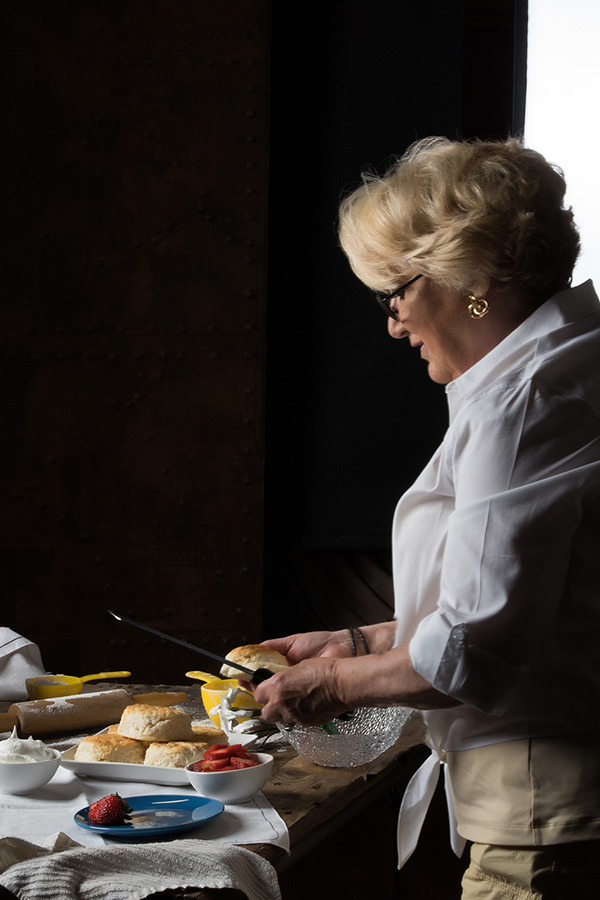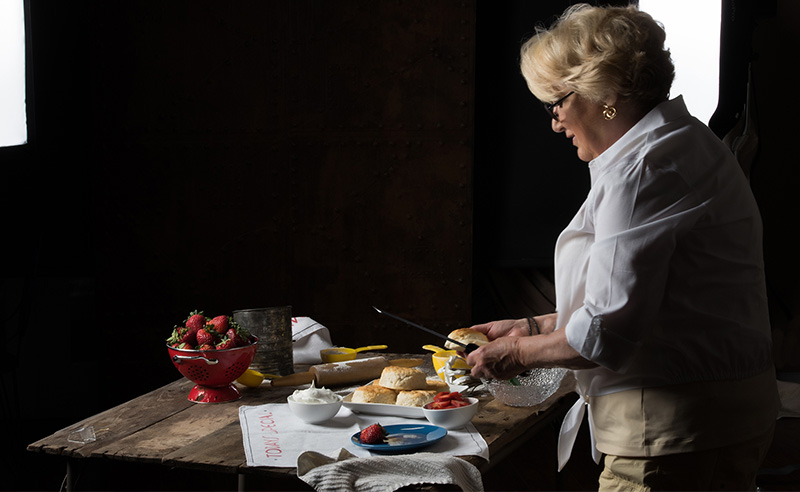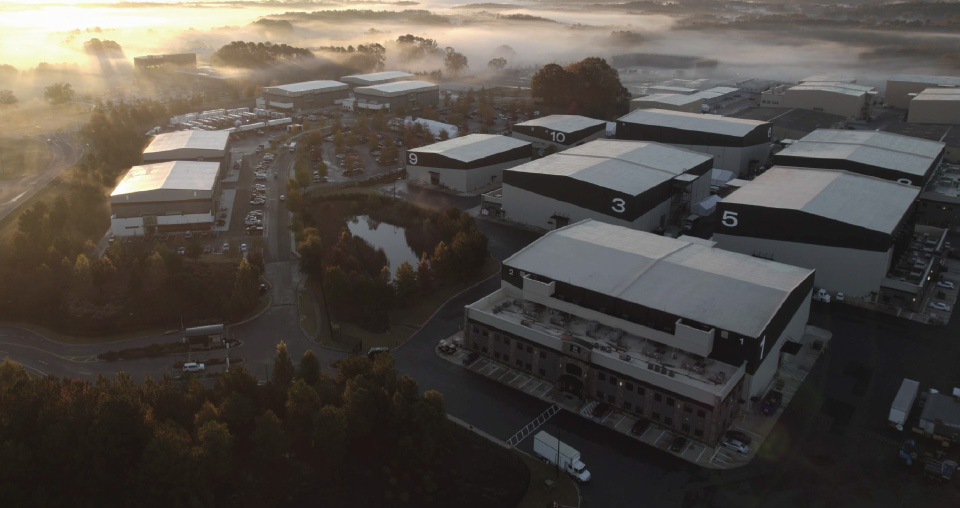By Charlene Perry
I am a food stylist. I am not a cook or a chef, but I am expected to cook and plate food for photographers to photograph. Sometimes the food is eaten by the client; in those cases, I will not taint the food with visual-enhancing chemicals.
A food stylist is expected to prepare and style food for photography or on-air demonstrations. I consult with marketing and art directors, who decide which foods will be photographed. In addition, I will design and prop the set where we are photographing the food from my prop inventory.


If this sounds easy, perhaps you might want to accompany me on set one day to find out for yourself how physically laborious a fried egg or hamburger could possibly be to shoot. Many times, the photo shoot is attended by the advertising agency staff and art directors–on occasion, even the client. As I build the set with food and props, there are many items included in the set. The art director will make sure I don’t place a prop where they are planning to place a copy, or I make sure something is not overpowering the look of the food, like conflicting colors of props or side dishes;The hero or star of the shot must be noticed in 3 seconds. Once I have styled the set, the photographer begins to find the best lighting angle and focus of the shot. While this is taking place, the food actually has a stand-in and once the set is ready for the final fresh dish, I place the star on set. The average time is three hours to get one good shot.
Prior to the shoot, I spend two to six days pulling food from grocery store shelves. On the first day of the shoot, I carry as much as $1,000 worth of food to the shoot. On shoot day, I crawl around on floors and lean over sets that can be up to four-by-four in size, all while dodging hanging lights, cameras, and microphones in and around this small square space.
This is something I have done most of my life. There is nothing more rewarding to me than to walk into a McDonald's restaurant and see a huge poster of a buttermilk chicken sandwich, which I have styled for all the world to see in every McDonald's restaurant around the world. That's my work; I have worked very hard to get to the point that I am. Luckily, I've had the support of friends and family, because this is a feast or famine position. There's no guarantee you're going to work tomorrow. It's a word-of-mouth job search.
So how does one become a food stylist? It all started when I was a makeup artist for the film industry. I was working on a film in Georgia that was a screenplay from a very successful book about a murder.
This has a dream sequence in the film in which the leading actress needed to look like she had gone insane. Hair sticking up, mascara dripping from her eyes–you get the picture.
She was hysterical, according to the screenplay. The actress, however, did not want to look bad. She insisted that the director and the producer get involved in the conversation about her image. The producer, director, myself, and the actress were standing together for this conversation. They completely supported the actress. As soon as she walked away, they turned to me and said, ’Follow the script.’ Shortly thereafter, I was working on another project in which the model did not like the way my makeup felt on her face. She wanted to use her makeup. Once again, conflict between my subject and my artistic ability was up for discussion (I want to interject, I am a dang good makeup artist).
After that gig, I decided that since I had done some food styling and loved it, from this point on, I was going to do food because ’food does not complain.’ No more people! I continued to focus on my food gigs and sharpen my skills as a food stylist, although Atlanta didn't have much of a call for food styling at that point.
I did not grow up in a meat and potatoes community. I was raised in Miami at a time when Miami and Miami Beach chefs excelled at conventions, meetings, and restaurants. I saw extraordinarily-plated presentations. Then, in my early career, I was flying with PanAm Airways. Their flight service training focused on attendants learning how to plate the food and how to ‘French serve.’ So, early on, food was slowly coming into my professional development.
I started freelancing as a makeup artist when I was living in New York. My roommate was a makeup artist at a major cosmetics store for the theater industry. When I wasn't flying, I was drafted to work in the makeup center so I learned the techniques of stage makeup as well as photography makeup. I later went to work as a traveling makeup artist when I left PanAm and NYC. So when I came to Atlanta, I had the opportunity to work many freelance gigs as a traveling makeup artist and then worked in the flourishing film and multimedia business here.
Having grown up in Miami, I was introduced to the film industry in Florida. By the time Atlanta started producing films, I was a seasoned professional. I've never really had the desire to be behind the lens of the camera, but the more you know about lighting and angles, the better a food stylist you become. I also understand special effects and how to make them. So when you want smoke coming off of the food, there are all kinds of techniques you can use.
Transferring my skills from makeup to food was easy. I took design classes, so I knew how important color is to successful food styling along with composition and the placement of the food. Understanding who your client is and what is important to them is also critical to success.
I once did a shoot for a vodka company. The vodka did not show up in time, and we had to shoot the whole series without the vodka. Not mentioning any names here, but the product was not really missed because you couldn't see it in the drink. However, if you're shooting ice cream, you can't use somebody else's product or a fake product. Ice cream is the star of the show. If chicken is the star of the show, you cannot substitute another product. It's very important to understand the legalities of shooting the client's food. Another aspect of shooting food for TV shows is the recipe. Use all of the ingredients of the written recipe. Use all the portion control of the ingredients as well.
Understanding this is important as an ethical food stylist. When I shoot, I have two rules. First, I want to give my client 100% of my skill and talent so they don't have to ‘fix it in post.’ Then, in television production, where we're looking at the whole production, I need to stay on schedule.
"As soon as she walked away, they turned to me and said, ’Follow the script.'"
People frequently ask what is the worst shoot I've ever done. I do have a nightmare that comes under the category of ‘Holy Crap-on-a-Cracker.’ The client was a manufacturer of kitchen equipment for home cooks. It was a multi-day shoot in a private home with obvious first-time art directors. My staging option was a screened-in porch right off the kitchen. It was the middle of January; temperatures are normally mild. However, on the last day of this nightmare shoot, the temperature dropped into the teens
The company had to replace the inexperienced team of art directors after the first shoot day. We were still able to prepare and shoot all of the scheduled meals. We were shooting a cake on the last day of the shoot. When the temperature dropped, the outside oven had no insulation and it could not generate enough heat to cook the cake.
The homeowners were staying in a four-star hotel for the shoot. During the shoot, the homeowner's brother died. The last day of the shoot was over at 7:00 p.m. We had to finish, but the cake was not fully baked. The only part of the cake that appeared to look like a cake was the rim around the cake, but it was still oozy in the center. The homeowners wanted to get back in their home, but we had to do the last shoot. The last shot was only successful because I hid behind the island counter, holding up the back of the cake. The photographer lowered the angle of the shot so it only got the front of the cake.
All the while, the homeowners are pounding on the door, yelling for the crew to leave, as friends and family are coming in from out of town for the funeral. We are throwing stuff into the cars, vans, and trucks to evacuate the place. We finally finished; the homeowners got their home back and the client was happy. Honest, readers, I can't make this stuff up.
But it's not all disasters, and some things work out really well. I was booked to shoot a Super Bowl video commercial for a chicken wing restaurant. I spent my time frying and plating chicken wings. My previous shoot was for another vodka company in which numerous cases of vodka were shipped in for the shoot that had 87 flavors and 87 different vodka drinks. The art director gave all the crew a case. I don't drink, but it was Christmas time and my sister was having a huge Christmas party in her home in Hilton Head, so I brought approximately 400 leftover chicken wings and a case of leftover vodka. Needless to say, we had one heck of a fun Christmas party that year. Food styling has great perks!
I am an artist, but when people hire me, they hire me because they are confident that I understand their vision. I take that very seriously. The customer knows what they want; they want you to listen to what they want, and they expect you to give them what they want. Sometimes we are provided with photos showing what they want, but many times we don't have those photos. It's important to listen and realize that you are the interpreter of the conception of the art director, because it can be very subjective. When I am hired by an art director, it's not my job to create a masterpiece of my own creation. It is my job to create the art director's vision of a masterpiece. It's a team effort between the art director, the client, and the photographer. I cannot take 100% of the credit. I am only one piece of the formula. And I love what I do.


